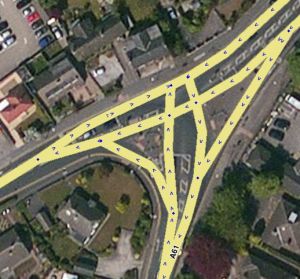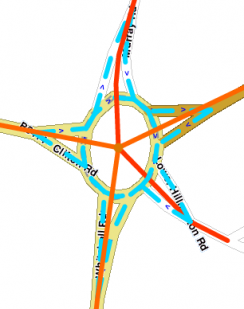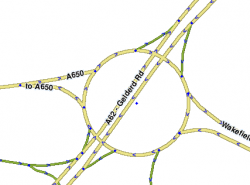Introduction
| This forms part of UK Editing Best Practice. Editor are encourage to follow these guidelines. |
As with all mapping in Waze, all types of junctions should be drawn as simply as possible to give clear instructions. At this time, November 2017, Waze does not give lane guidance and adding additional segments at junctions can lead to complex & confusing instructions and the possibility of introducing errors. For a comprehensive guide on editing junctions in general please read the Global Junction Style Guide.
Junctions
T-junctions, cross roads, and the majority of junctions are usually best mapped as single 2-way segments that are connected with a single node. Complex junctions that include restrictions, large (distinct) turn lanes may benefit from a more complicated layout.
The original UK map import , know as the UK basemap, had a lot of junctions mapped as split 1-way roads due to little more than some painted chevrons in the middle of the road. This is completely unnecessary, and any remaining should be simplified where possible.
 |
 |
Roundabouts
Roundabouts are no exception, most can be mapped with single 2-way segments for each connecting road. Much of the UK basemap had pairs of 1-way entry and exit segments which are not necessary. If you are rebuilding a roundabout take the opportunity to remove these segments. They will look much better on the client and can lead to normal roundabout instructions.
Steps for redrawing a roundabout
 |
 3. Drag 2-way segments to the centre |
 |
- Delete roundabout and 1-way "V"s
- Drag main 2-way segments to the centre
- Draw new roundabout
Small and mini-roundabouts should be drawn as large as possible. Any with a radius much less than 10m will not be visible on the client, so aim to get them close to this size if you can.
- See Roundabouts/USA for detailed instructions.
Naming Roundabouts
After drawing a new roundabout, it is important to change the road type to that of highest connecting road (except Freeway), and set the address. If the address is not set correctly, the new segments will be drawn in red.
To aid navigation instructions, roundabouts should remain unnamed. If the roundabout does have a proper, signposted name, then for this can be labelled using a 'Junction/Intersection' type Place that fills the centre of the roundabout.
Common Issues With Roundabouts
- If a roundabout doesn't have a central node or === symbols around the edge, then it is not a proper roundabout. The client will give 'keep left' and 'keep right' instructions instead of 'take the nth exit'. These junctions need to be deleted and redrawn.
- If two entry and exit segments share the same junction on the roundabout, the exit will not be counted when entering at that junction. Entry and exit segments should always be connected via separate junctions.
- Sometimes the client will say "Take the 0th exit" for a roundabout. This is often caused by an invisible node on or within the junction, and can only be repaired by deleting and rebuilding the entire roundabout.
- Roundabouts with a diameter of 10m or less won't be used for u-turns in a waze route (country specific config)
Special Roundabouts
Sometimes a roundabout will get modified to change its shape and function, such that it is no longer a simple a roundabout.

One such example is the "Hamburger Roundabout", where the main carriageway goes straight through the middle of the junction. This should be drawn as if the main road was an over pass, with short ramps connecting it to the roundabout. The example here is near M62 Junction 27 (Leeds).
Some roundabouts get modified so much that they can no longer be considered roundabouts at all. Here are some examples:
- M62 Junction 31 (Castleford)
« Back to UK Editing Best Practice